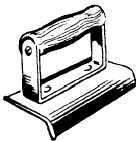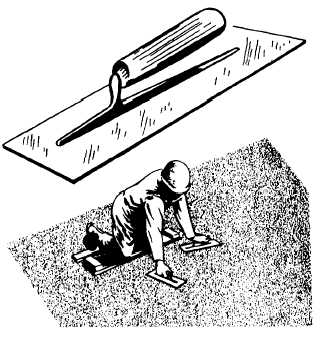Begin floating immediately after screeding while the concrete is still plastic and workable. However, do not overwork the concrete while it is still plastic because you may bring an excess of water and paste to the surface. This fine material forms a thin, weak layer that will scale or quickly wear off under use. To remove a coarse texture as the final finish, you usually have to float the surface a second time after it partially hardens.
EDGING
As the sheen of water begins to leave the surface, edging should begin. All edges of a slab that do not abut another structure should be finished with an edger (figure 7-48). An edger dresses corners and rounds or bevels the concrete edges. Edging the slab helps prevent chipping at the corners and helps give the slab a finished appearance.
TROWELING
If a dense, smooth finish is desired, floating must be followed by steel troweling (figure 7-49). Troweling should begin after the moisture film or sheen disappears from the floated surface and when the concrete has hardened enough to prevent fine material and water from being worked to the surface. This step should be delayed as long as possible. Troweling too early tends to produce crazing and lack of durability. However, too long a delay in troweling results in a surface too hard to finish properly. The usual tendency is to start to trowel too soon. Troweling should leave the surface smooth, even, and free of marks and ripples. Spreading dry cement on a wet surface to take up excess water is not a good practice where a wear-resistant and durable surface is

Figure 7-48.-Edger.

Figure 7-49.-Steel finishing tools and troweling operations.
required. Wet spots must be avoided if possible. When they do occur, however, finishing operations should not be resumed until the water has been absorbed, has evaporated, or has been mopped up.
Steel Trowel
An unslippery, fine-textured surface can be obtained by troweling lightly over the surface with a circular motion immediately after the first regular troweling. In this process, the trowel is kept flat on the surface of the concrete. Where a hard steel-troweled finish is required, follow the first regular troweling by a second troweling. The second troweling should begin after the concrete has become hard enough so that no mortar adheres to the trowel, and a ringing sound is produced as the trowel passes over the surface. During this final troweling, the trowel should be tilted slightly and heavy pressure exerted to thoroughly compact the surface. Hairline cracks are usually due to a concentration of water and extremely fine aggregates at the surface. his results from overworking the concrete during finishing operations. Such cracking is aggravated by drying and cooling too rapidly. Checks that develop before troweling can usually be closed by pounding the concrete with a hand float.
Continue Reading